 |
|
Every year, the city of Quito holds a series of bullfights known as the Feria de Quito or Feria de Jesus del Gran Poder.
This series of bullfights takes place around the end of November and first week of December leading up to Dec 6th, the day that Quito was founded by Sebastian Benalcazar in 1534. The purpose of this section is not to debate whether bullfighting is art, culture, tradition, humane or inhumane. Rather, I wanted to show some good photos of what a bullfight in Ecuador is like. |
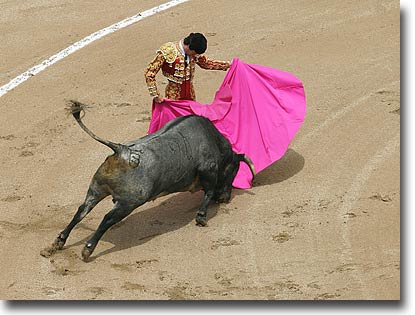 |
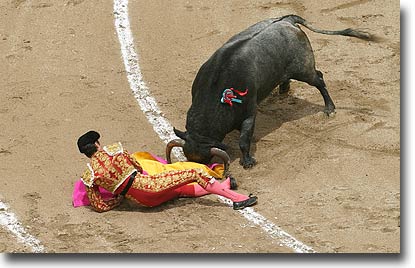 |
I am not a expert on bullfights, in fact this one was the first and only one that I have ever attended. I have done some research though over the years and I'll add some of my own personal observations and advice along the way in case you want to attend a bullfight in Quito.
My first piece of advice, get your tickets early and get to the bullring at least an hour or hour and a half beforehand. I spent nearly an hour in line and missed being able to photograph the initial procession and pagentry as the matadors, picadores, bandilleros and assistants the bullring at the beginning. |
|
Bullfights are not for the faint of heart. In Ecuador at least, the matador or bullfighter does kill the bull in the bullfights.
There is always a certain risk of danger to those within the ring. All of these photos were taken on Dec 6th, 2003. From the perspective of a photographer, I could not have picked a more exciting day to photograph the bullfights. The first bull was big and quite aggressive. In the first section of the bullfight, the bull knocked down the bullfighter Juan Diego and then proceeded to flip him over. You'll notice that the bullfighter is in mid-air, except for his toe. His hat is also in mid-air as is his shoe. |
 |
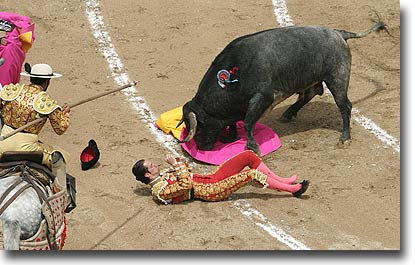 |
You'll notice in the next frame, taken 1/2 second later, how Juan Diego had tensed up his body to reduce injury from the bulls horns... You can note it especially on his face.
|
|
The bullfighter was knocked down as the horseman was entering the ring. The moment the bullfighter goes down, everyone quickly moves in to distract the bull. Spectators even throw in their hats to cause the bull to stop and look around.
|
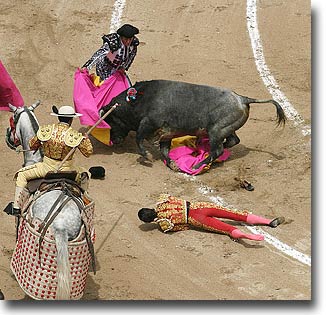 |
 |
In the first section of the bullfight, the matador uses the "capote", a magenta and yellow cape to take the bulls charges and he attempts to move his feet as little as possible. If he makes a graceful move as the bull charges by, the crowd will cheer him with an "OLE".
Then after the trumpets sound, the picador, or mounted horseman enters the ring staying to the outside of the two white chalk lines the circle the bull ring. The matador is supposed to keep the bull inside the inner white ring until the horseman is in place. |
|
The purpose of the Picador is to use his lance to cut some of the top neck muscle of the bull so that it is difficult for him to raise his head completely. This is really done to protect the bullfighter. The crowd, of course, doesn't care too much for this as it takes some of the sport out of the fight. So the crowd whistles loudly to try to get him to stop.
The bull managed to push the horseman into the inner part of the bullring causing the crowd to whistle loudly at the horseman for his inability to stay outside of the two white rings. |
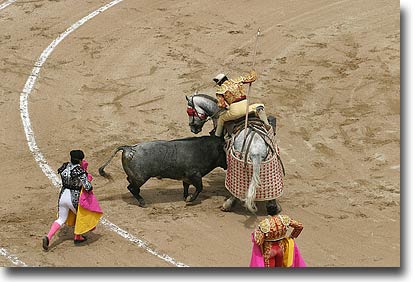 |
 |
So the matador or bullfighter comes to the rescue of the horseman and to reposition the bull inside the inner ring. You'll note that the Juan Diego has not yet replaced his shoe that the bull knocked off earlier. |
|
The horseman on the outside of the two rings successfully takes a second charge from the bull which started from inside the two rings.
However, The bull began pushing at the front of the horse causing it to turn and then began pushing it towards the center, once again causing the crowd to whistle loudly at the horseman for his inability to stay outside of the two white rings. |
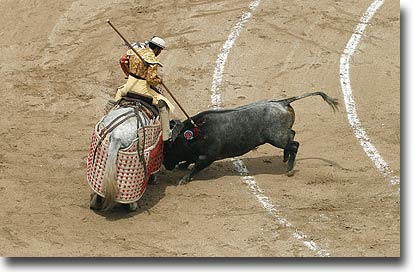 |
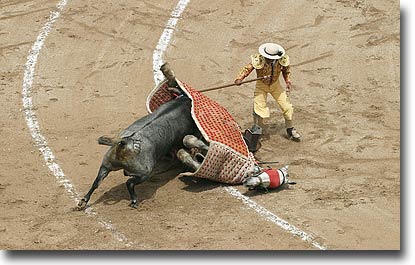 |
The bull then managed to topple over the horse and horseman causing the bullring to go wild in whisles, sort of a polite boo or jeer at the inability of the horsman to stay on top of his horse. |
| The moment the horse and the picador goes down, everyone quickly moves in to distract the bull. Spectators once again throw in their hats to cause the bull to stop and look around. | 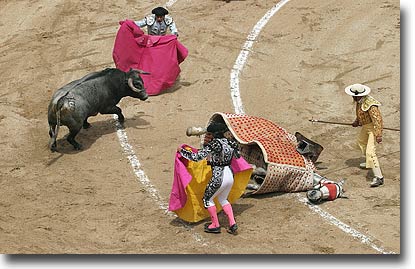 |
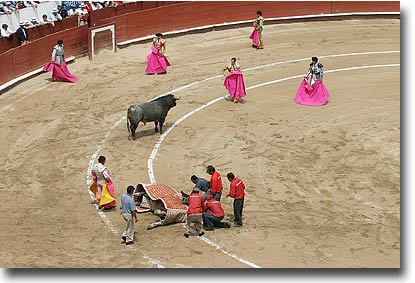 |
All of the matadors and aprentices come into the ring to distract the bull from the horse allowing the bullring crew to enter and right the horse back on it's feet. At which point the horse and rider quickly went out of the bullring, while the crowd continued to whistle at the horseman, jeering at his inability to stay on top of his horse. |
|
The next section is one of the most interesting. The banderillero will attempt to place two banderillas or barbed spears on the upper neck of the bull. It is a feat that requires a courage, skill and the ability to out manuver the bull in a race to safety. |
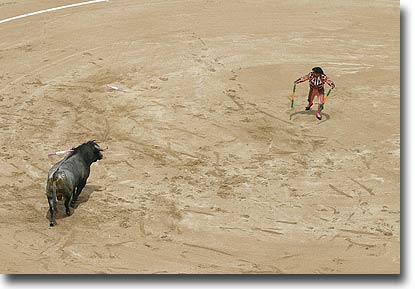 |
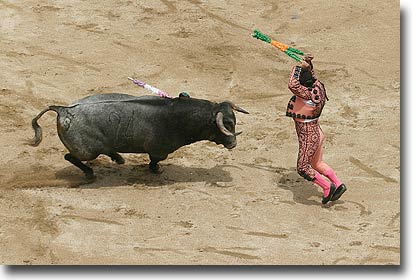 |
The apparent trick is to approach the bull fairly head on so that his body is facing the opposite direction. The banderillero still needs carefull timing as he jumps in the air to thrust in the barbed lances.
The moment to barbs enter the bulls neck, he lifts his head abruptly buying the banderillero precious seconds to begin running towards the safety of the bullring walls. |
|
The banderillero then runs as fast as he can to safety, with a couple slight moves to confuse the bull as to what direction he is heading.
I sincerely thought the bull was going to catch this guy... So did the crowd, judging by the gasps, shrieks and general commotion as he raced towards the fence. I should note that the purpose of the lances is to agitate the bull a bit as well as show the skill of the banderillero. |
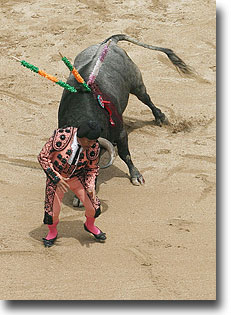 |
 |
A second banderillero comes out to attempt to place two more lances in the bull.
Informal bullfighting began in Spain actually as a necessity. In the beginning there were many wild bulls who actually endangered the people of the Iberian penisula. Later during occasional breaks in battles the Moors and Christians, bullfighting began to become more of an event in which knights showed their abilities and horsemanship by battling bulls. Actually bullfighting really originated from the Moors, but modern bullfighting originated in Spain. The first recorded bullfight (in which a Spaniard took part) took place sometime between 1056 and 1065. Rodrigo Diaz de Vivar, or El Cid, competed against Moorish knights in killing bulls in the presence of Ferdinand I. (Note: there are a lot of discrepancies in historical dates about bullfighting on the web... I'll explain more about the history in parts 2 and 3 of this series.) Never the less, these wild bulls from Spain in fact were so agressive, that the Roman Catholic church first brought them into central America to chase Indians off of their plantations.
|
|
Bullfights in Ecuador were done informally in various places including the plaza in front of the Sucre Theatre, which actually began as a butcher shop/ slaughter house. It wasn't until the late 50's that bullfights became a part of the Quito day celebration. In the beginning, the Franciscan priests actually awarded a trophy to the best matador of the series. This explains in part the reason for naming the bullfights the Feria de Jesus del Gran Poder; after an icon in the San Francisco Cathedral in Quito. |
 |
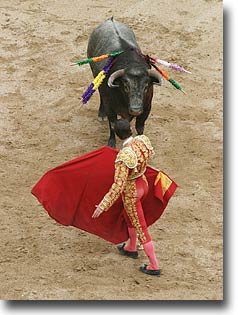 |
The bullfight now enters the faena, the final third or last section of the bullfight. Notice that the bullfighter now uses the "muleta" a red cape as opposed to the "capote" magenta and yellow one.
|
|
Some people have asked why people go to a bullfight and watch a bull being killed. There are a number of different reasons proposed, but my observation is that the bullfight is really about the matador, not the bull.
In fact in many ways the bullfight is like olympic gymnastics. Bullfighting requires bravery, technique, athleticism and artistry. To recieve a medal in bullfighting, one must display all of these during the fight. |
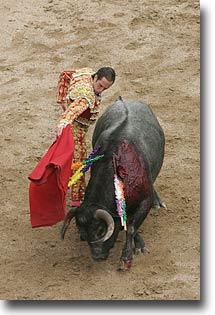 |
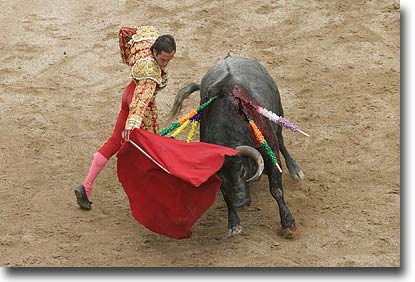 |
In gymnastics, no matter how well one does during the routine, the dismount in the end will determine whether a person wins or loses. But even a perfect dismount will not redeem a technical error made earlier in the routine. Athleticism and even daring moves will not by themselves guarantee a gymnist a medal if the gymnist does not perform with grace and artistry.
In bullfighting the dismount is the killing of the bull. And basically it comes down to being able to kill the bull quickly with one thrust of the sword. And for that reason, the bullfighter must ultimately kill the bull, otherwise there is no way to prove the complete skills of the bullfighter. |
|
That said, before the matador kills the bull, If the bull has been particulary noteworthy, the crowd can petition the president of the bullring to let the bull live. This bull was one that I would have voted to be spared and several people did shout "que vive el toro" or let the bull live. Also the bullfighter only has about 13 minutes to kill the bull, if that time passes, the bull goes free.
Done quickly, I personally find bullfighting to be at least as "humane" if not more than death by hunting with a rifle or shotgun and much more so than trapping. The bull at least is allowed to fight back and does have a chance to survive in the end. It's head is not destined to be stuffed and hung up on a wall somewhere and it's meat is donated to local orphanages. But this is not an issue that everyone will ever agree on. |
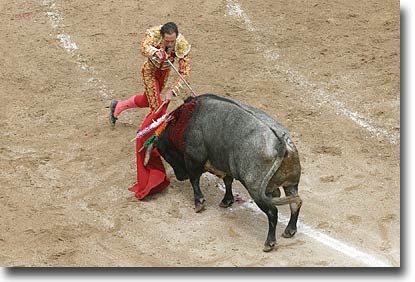 |
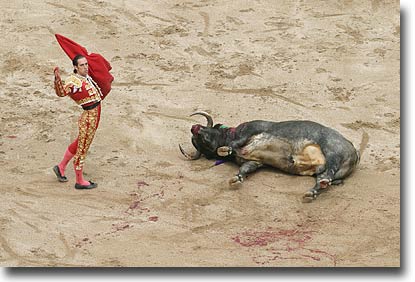 |
In this case, the bull died a quick death. The matador really was one of the best of the Feria de Quito and Juan Diego would have been awarded a prize had he not been knocked down early in bullfight.
The award is actually decided by the president of the bullring. The crowd however gives it's perspective by raising white hankerchiefs in the air. The president then raises white hankerchiefs in his hands to signal the award to be given to the matador. One hand means one ear from the bull, two means two ears and in theory for an exceptional performance, he can also award a tail, have him carried on shoulders around the ring and even out the main door of the bull ring. Due to the knockdown in this case however, even though the rest of the bullfight was done well, the matador did not recieve any ears or award. |
|
The matador then parades around the ring as the crowd claps, cheers, throws roses or hats to show their approval of his performance. The bullfighter will sometimes pick up a hat thrown to him and attempt to throw it back up to the person who threw it at him. |
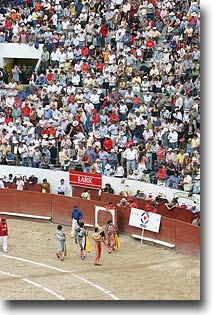 |
 |
Part one was really a classic Spanish bullfight performance by Juan Diego.
In part two, we'll see the spectacular two ear performance of Andy Cartegena, a Spanish rejoneador (mounted bullfighter) that does the entire bullfight from start to finish while riding horseback. In part three, we'll see the Ecuadorian bullfighter Juan Pablo Diaz, who takes the bull's initial charge out of the gate while kneeling in the ring. It was certainly entertaining to watch and photograph. I hope you'll enjoy it as well.
|